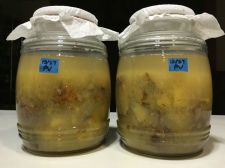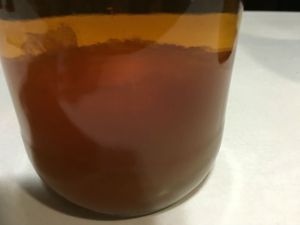 Two batches of pineapple scrap vinegar are sitting on the counter, fermenting. It’s a good way to use the parts of a pineapple you’d throw out (or maybe compost), and you end up with a useful product.
Two batches of pineapple scrap vinegar are sitting on the counter, fermenting. It’s a good way to use the parts of a pineapple you’d throw out (or maybe compost), and you end up with a useful product.
Pineapple scrap vinegar starts with the skin, core, and any non-edible bits of the fruit you wouldn’t care to eat. Note: not spoiled parts – just bruised or “woody” parts. Basically, you cut it up, add ugar water, stir, cover with a rubber-banded paper towel, and let it do its thing. You stir it daily, and if all goes well, you end up with probiotic-filled vinegar that you can use in dishes or add to your chickens’ water for a healthy boost.
 We’ve made a few batches now, and here are some lessons learned: inoculate with finished pineapple vinegar to help ensure mold won’t grow, and don’t overcrowd the jar with pineapple. A couple of batches did grow fuzzy white mold and were tossed. Once we added finished vinegar to the new batches, that stopped.
We’ve made a few batches now, and here are some lessons learned: inoculate with finished pineapple vinegar to help ensure mold won’t grow, and don’t overcrowd the jar with pineapple. A couple of batches did grow fuzzy white mold and were tossed. Once we added finished vinegar to the new batches, that stopped.
You can also make fruit scrap vinegar with other fruits, like apples. Pineapple is instant gratification, though – you don’t have to collect fruit scraps over weeks to have enough to start a batch. Two medium pineapples seem to be enough to start two (approx.) 32 oz. jars.
 People cook with pineapple vinegar and use it in dressings. It smells a little reminiscent of cat pee to me, so I tend to use it in the chicken and ducks’ water (and they don’t seem to mind). They also eat the “blob” (SCOBY) that sometimes forms in the bottles and flops out, when poured, into their water.
People cook with pineapple vinegar and use it in dressings. It smells a little reminiscent of cat pee to me, so I tend to use it in the chicken and ducks’ water (and they don’t seem to mind). They also eat the “blob” (SCOBY) that sometimes forms in the bottles and flops out, when poured, into their water.
So what are you waiting for? Get to fermenting.
